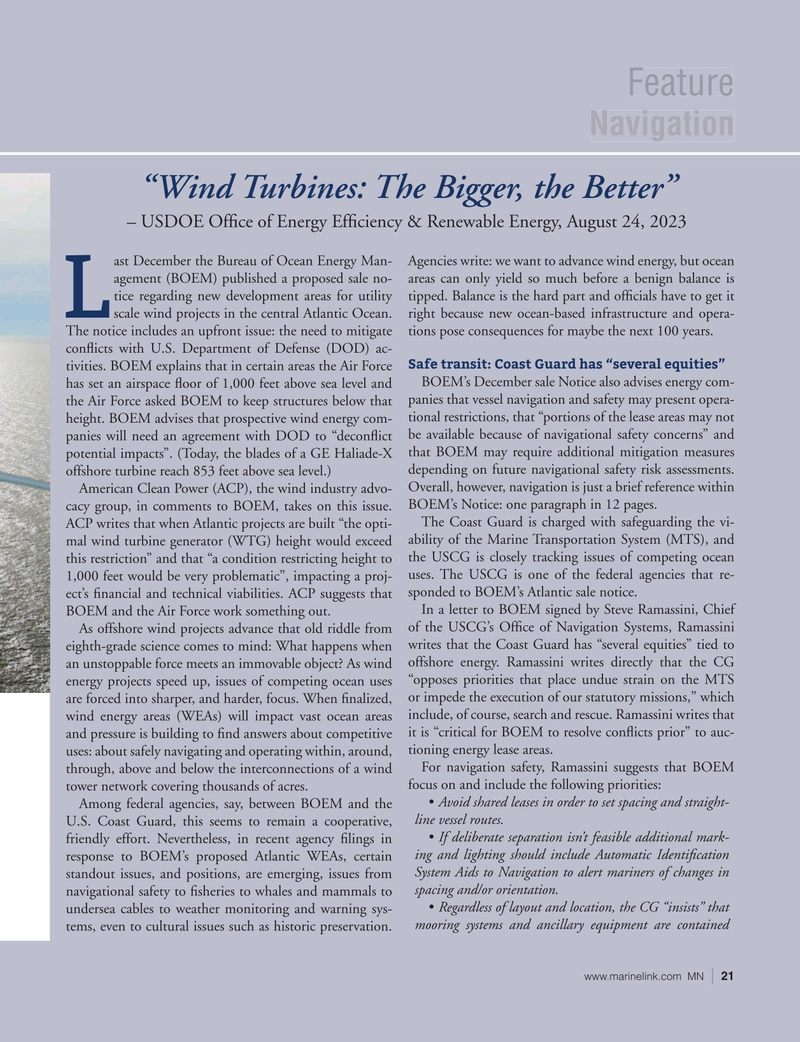
Page 21: of Marine News Magazine (April 2024)
Read this page in Pdf, Flash or Html5 edition of April 2024 Marine News Magazine
Feature
Navigation “Wind Turbines: The Bigger, the Better” – USDOE Of? ce of Energy Ef? ciency & Renewable Energy, August 24, 2023 ast December the Bureau of Ocean Energy Man- Agencies write: we want to advance wind energy, but ocean agement (BOEM) published a proposed sale no- areas can only yield so much before a benign balance is tice regarding new development areas for utility tipped. Balance is the hard part and of? cials have to get it
L scale wind projects in the central Atlantic Ocean. right because new ocean-based infrastructure and opera-
The notice includes an upfront issue: the need to mitigate tions pose consequences for maybe the next 100 years.
con? icts with U.S. Department of Defense (DOD) ac-
Safe transit: Coast Guard has “several equities” tivities. BOEM explains that in certain areas the Air Force
BOEM’s December sale Notice also advises energy com- has set an airspace ? oor of 1,000 feet above sea level and the Air Force asked BOEM to keep structures below that panies that vessel navigation and safety may present opera- tional restrictions, that “portions of the lease areas may not height. BOEM advises that prospective wind energy com- panies will need an agreement with DOD to “decon? ict be available because of navigational safety concerns” and potential impacts”. (Today, the blades of a GE Haliade-X that BOEM may require additional mitigation measures depending on future navigational safety risk assessments. offshore turbine reach 853 feet above sea level.)
Overall, however, navigation is just a brief reference within
American Clean Power (ACP), the wind industry advo- cacy group, in comments to BOEM, takes on this issue. BOEM’s Notice: one paragraph in 12 pages.
The Coast Guard is charged with safeguarding the vi-
ACP writes that when Atlantic projects are built “the opti- mal wind turbine generator (WTG) height would exceed ability of the Marine Transportation System (MTS), and this restriction” and that “a condition restricting height to the USCG is closely tracking issues of competing ocean uses. The USCG is one of the federal agencies that re- 1,000 feet would be very problematic”, impacting a proj- ect’s ? nancial and technical viabilities. ACP suggests that sponded to BOEM’s Atlantic sale notice.
In a letter to BOEM signed by Steve Ramassini, Chief
BOEM and the Air Force work something out.
As offshore wind projects advance that old riddle from of the USCG’s Of? ce of Navigation Systems, Ramassini eighth-grade science comes to mind: What happens when writes that the Coast Guard has “several equities” tied to an unstoppable force meets an immovable object? As wind offshore energy. Ramassini writes directly that the CG energy projects speed up, issues of competing ocean uses “opposes priorities that place undue strain on the MTS are forced into sharper, and harder, focus. When ? nalized, or impede the execution of our statutory missions,” which wind energy areas (WEAs) will impact vast ocean areas include, of course, search and rescue. Ramassini writes that and pressure is building to ? nd answers about competitive it is “critical for BOEM to resolve con? icts prior” to auc- uses: about safely navigating and operating within, around, tioning energy lease areas.
For navigation safety, Ramassini suggests that BOEM through, above and below the interconnections of a wind focus on and include the following priorities: tower network covering thousands of acres.
• Avoid shared leases in order to set spacing and straight-
Among federal agencies, say, between BOEM and the line vessel routes.
U.S. Coast Guard, this seems to remain a cooperative, • If deliberate separation isn’t feasible additional mark- friendly effort. Nevertheless, in recent agency ? lings in ing and lighting should include Automatic Identi? cation response to BOEM’s proposed Atlantic WEAs, certain
System Aids to Navigation to alert mariners of changes in standout issues, and positions, are emerging, issues from spacing and/or orientation.
navigational safety to ? sheries to whales and mammals to • Regardless of layout and location, the CG “insists” that undersea cables to weather monitoring and warning sys- mooring systems and ancillary equipment are contained tems, even to cultural issues such as historic preservation. www.marinelink.com MN 21|

 20
20

 22
22
